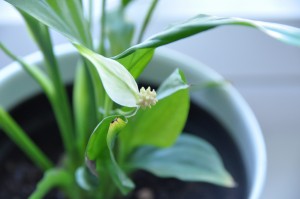By Dr. Craig A. Maxwell
Just because old man winter is on his way, doesn’t mean that summer’s influence is done for the year. As the frost settles in and temperatures continue dropping, we can still prosper from the beautiful benefits of Mother Nature. Although winter tends to be a time of hibernation, with limited time for outdoor activities, many of us can choose to bring the great outdoors inside this season. Bringing a plant or two indoors this winter will add more oxygen and a little color to your life.
Natural Air Purifiers
Spending much more time indoors can take a toll on our health. “In the late ’80s, NASA and the Associated Landscape Contractors of America studied houseplants as a way to purify the air in space facilities. They found several plants that filter out common volatile organic compounds (VOCs). Lucky for us the plants can also help clean indoor air on Earth, which is typically far more polluted than outdoor air.” Adding a houseplant to any room will increase air quality and help in boosting the immune system. Follow my list below, and learn how to keep your indoor air clean with my favorite indoor plants.
10 Most Beneficial Indoor Plants
1. Spider plant (Chlorophytum comosum)
This resilient plant counteracts the effects of carbon monoxide, benzene and formaldehyde. Decreasing the effects of these toxins will increase oxygen levels in the home. This plant thrives indoors and requires an average room temperature between 65-75 degrees F (18-24 degrees C). Needs moderate light and moderate humidity. Keep soil evenly moist and avoid direct sunlight when caring for this plant.
2) Snake plant (Sansevieria trifasciata ‘Laurentii’)
As a wonderful addition to any bathroom, this plant thrives in more humid conditions and decreases the levels of formaldehyde indoors. Found in many household products, and widely used in carpet and furniture manufacturing, formaldehyde can linger in the household air through off-gassing. Snake plants require low light, little attention and little water. Their leaves are succulent and accustomed to absorbing moisture.
3) Aloe (Aloe Vera)
This useful plant thrives indoors and requires very little attention. Good on kitchen counters and/or warm living rooms with plenty of natural light. For best results, purchase a plant during the summer months and allow it to prosper outdoors prior to bringing inside for the winter. Keep the soil moderately fertile and planted in a fast draining pot. Aloe Vera also contains many minerals essential to the immune system, and is a very popular remedy for many conditions.
4) Golden pothos (Scindapsus aures)
This plant needs very little light and is accustomed to handling erratic watering as well as challenging living conditions. Known as the easiest indoor plant to take care of, this green beauty is a good-looking plant suitable for any room inside the house (even the garage or basement). Golden pothos is another effective plant at battling formaldehyde and its toxic qualities (prevalent in car exhaust fumes).
5) Warneck dracaena (Dracaena deremensis ‘Warneckii’)
Great additions to any home or office space, these plants require minimal care and come in a variety of shapes and sizes. They prosper in both artificial lighting and natural sunlight. The less light, the less watering required. These plants help combat common pollutants associated with oils and varnishes often found indoors.
6) Bamboo palm (Chamaedorea sefritzii)
This small palm thrives in shady indoor spaces and often produces flowers and small berries. Known to balance out the damaging effects of benzene and trichloroethylene, this plant looks good while doing its job. Perfect for placing around furniture (leather couches and/or chairs) that could be off-gassing formaldehyde. These floor plants can grow up to 7 feet over time, and are easy to care for requiring low to moderate light. Leaf tips turn pale and green; leaves will drop prematurely due to over-watering. Thrives in moderate to warmer temperatures.
7) Chinese evergreen (Aglaonema Crispum ‘Deborah’)
This particular hybrid tolerates low light and dry conditions better than most of the other houseplants. Cold air is their weakness, so be sure to keep this plant near an adequate source of heat. This plant requires watering regularly and will help remove air pollutants and toxins as the time passes. The longer you keep this plant hanging around, the more effective it becomes at filtering your airspace.
8) Peace lily (Spathiphyllum)
“Shade and weekly watering are all the peace lily needs to survive and produce gorgeous blooms. It topped NASA’s list for removing all three of most common VOCs — formaldehyde, benzene and trichloroethylene. It can also combat toluene and xylene.” Don’t worry about guessing when it’s time for watering because this plant will let you know when it’s thirsty (sags a bit when ready for water). The Peace lily prefers medium, indirect sunlight and thrives in moderate indoor temperatures.
9) Gerber daisy (Gerbera jamesonii)
This gorgeous flowering, indoor plant is sure to add some color to the dismal days of winter. This plant will require plenty of attention, but everything beautiful involves a little work. Gerber’s require 3-5 hours of direct sunlight daily. These flowers do their best in warmer temps, so keep the heat turned up this winter if you’re planning on the Gerber Daisy to help brighten those gloomy days.
10) Chrysanthemum (Chrysantheium morifolium)
Mums are the word when it comes to color this cold season. This plant requires plenty of direct sunlight to keep those budding blooms open; warmer indoor temps are also a plus. Known to help filter out the damaging effects of benzene (commonly found in detergents, glue, paint and plastics), these plants will show their true colors when kept close to windows or below skylights giving them plenty of natural sunlight daily.
Find out more about staying healthy and surviving the indoor mood this season, by asking me about additional supplements that will help balance out those blustery winds of winter emotion. The best way to weather any storm is by planning ahead. Stay well friends!









